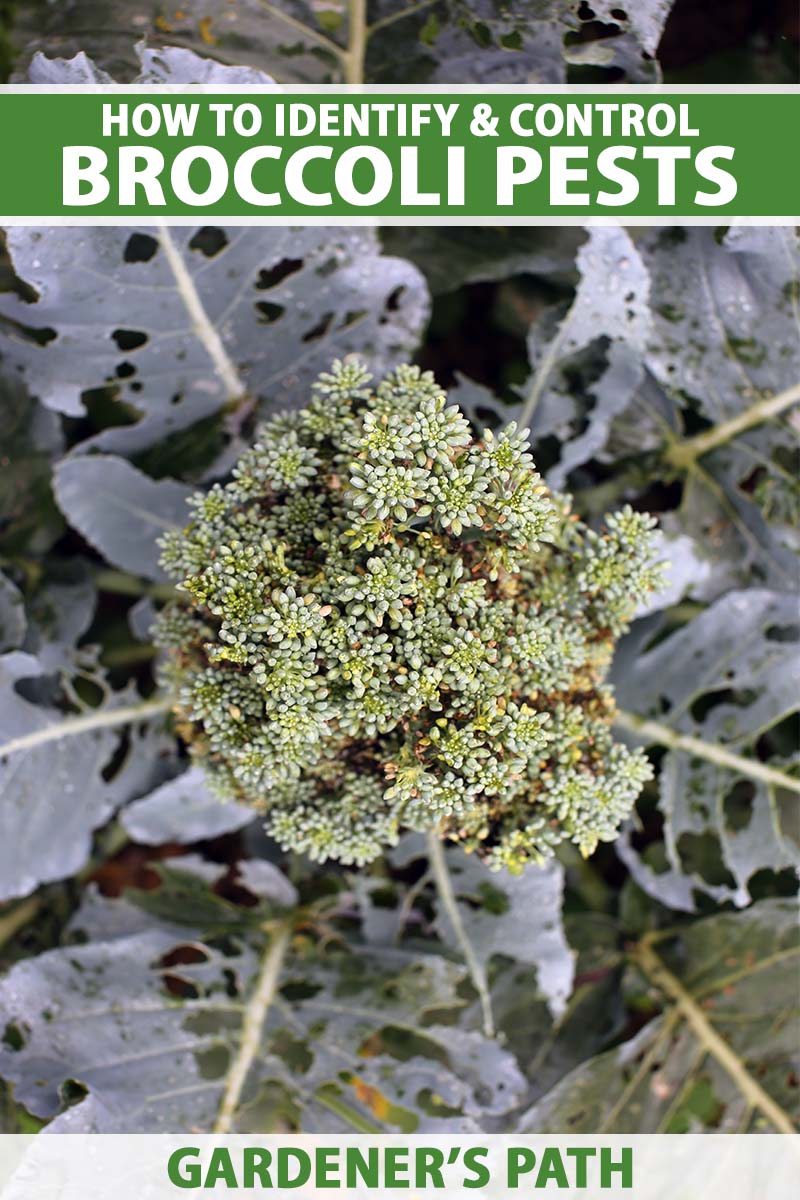Insecticide For Broccoli Plants
Pests are a part of every gardener’s life, but you don’t have to let them win. Let’s jump in!
1. Aphids
Dealing with aphids is frustrating because they’re so common. Plus, they can spread disease. But on the bright side, they’re also fairly easy to deal with.
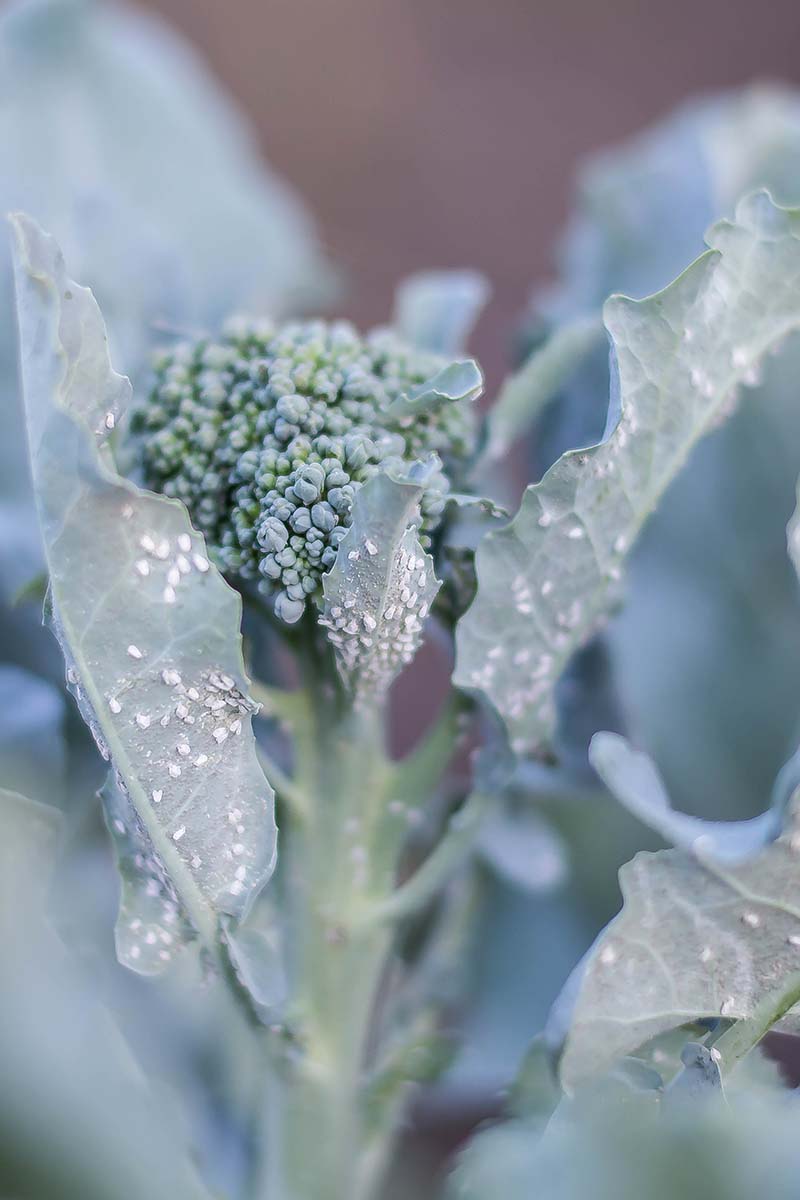
Broccoli plants are commonly infested by cabbage (Brevicoryne brassicae) and turnip aphids (Lipaphis erysimi), in particular.
Don’t worry too much about which type you’ve got.
All aphids are treated the same way.
2. Cabbage Loopers
Cabbage loopers (Trichoplusia ni) are inch-long green caterpillars. They’re common across the US and they love to munch on brassicas.
Plus, they’re voracious and they can rapidly leave your plant looking more like green Swiss cheese than a veggie you’d like to eat.
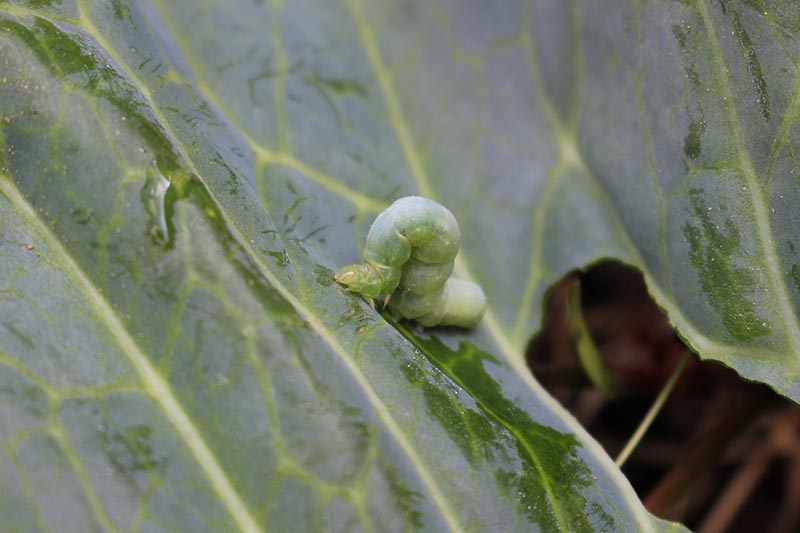
They don’t stop at the foliage, either. The worms can burrow into the heads of your broccoli. That’s not a surprise you want to find when you’re prepping your harvest in the kitchen.
3. Cabbage Root Maggots
Cabbage root maggots (Delia radicum) don’t look like much. The adults resemble small house flies, and the larvae are grub-like maggots that grow to about a third of an inch long.
But don’t let that fool you. Despite their unimpressive appearance, they can do quite a lot of damage.
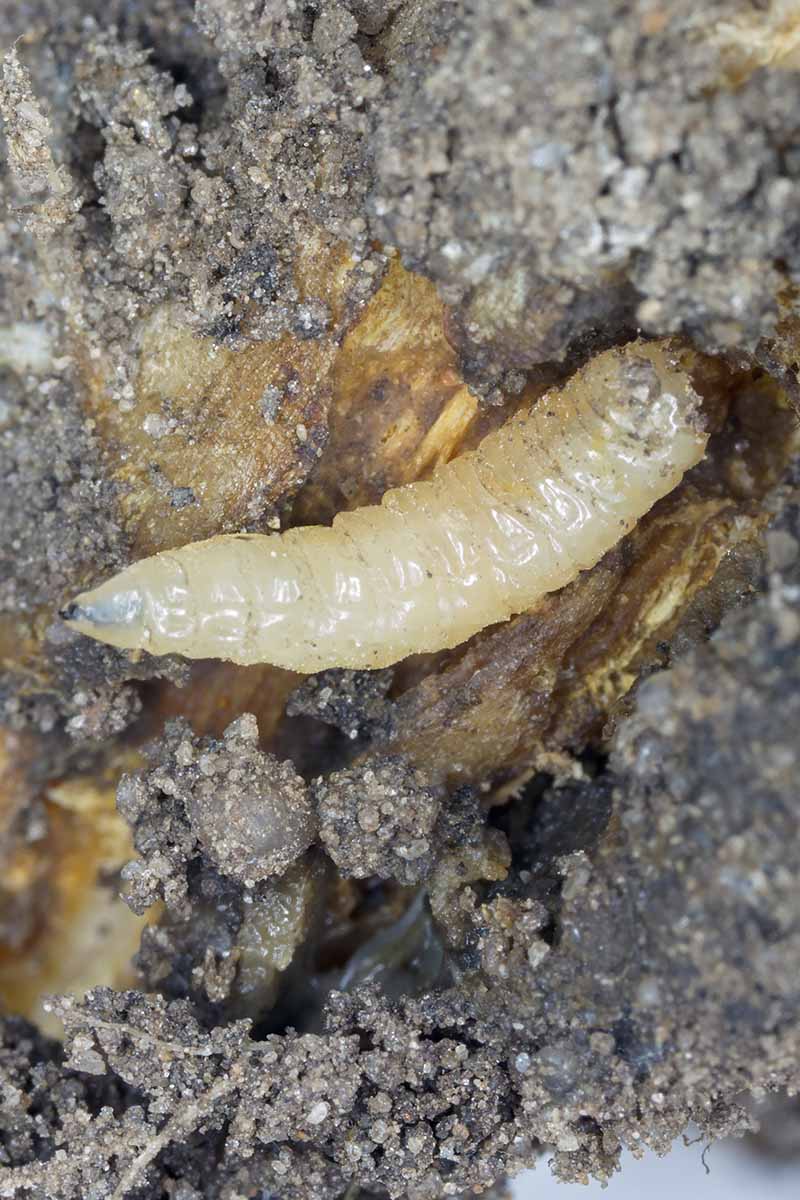
The larvae attack the plant’s roots, and you won’t usually know you have an infestation until the damage is done. That makes prevention and the ability to spot these pests early on essential.
Fortunately for us (and unfortunately for cabbage maggots), our guide will help you become an expert in dealing with them.
4. Cabbage Webworms
Cabbage webworms (Hellula rogatalis) are common in the southern half of the US, though there have been reports of them as far north as Nova Scotia, Canada.
These half-inch brown and tan worms have a black cap on their heads, and they can totally destroy your harvest.
They emerge in groups of hundreds to feed on plant buds and leaves, but it only takes two to destroy a plant significantly enough to ruin your broccoli harvest.
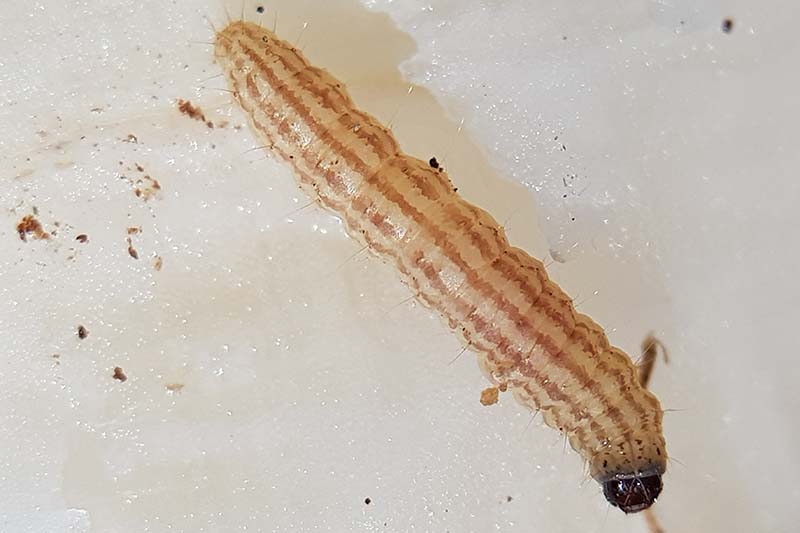
They can bore into the buds, which kills them. If this happens, you might see a few subsequent lateral buds develop, but they usually won’t grow large enough to eat or they’ll be distorted. That means no broccoli for you!
They also fold leaves and spin webs all over foliage, which stunts the plant’s growth. In large enough numbers, they can even kill an entire plant.
They’re active in the fall, so if you’re growing your broccoli in the spring, you’re home-free.
Everyone else, though… well, you’ll have to be on the alert.
The Old World cabbage webworm (Hellula undali) is often confused with the common cabbage webworm. They do similar damage, look similar, and may be controlled in the same way.
The main difference is that they appear in a wider range of areas, from Hawaii to Asia.
Fortunately – since they’re so destructive – there are lots of ways to control either of these webworm species. Handpick them when you spot them and drown them in soapy water.
You should also encourage beneficial predators to visit your garden, like birds, ladybugs, and yellowjackets.
Products that contain Bacillus thuringiensis subsp. kurstaki such as Monterey Bt Liquid are effective, particularly if you apply them right as the worms emerge.
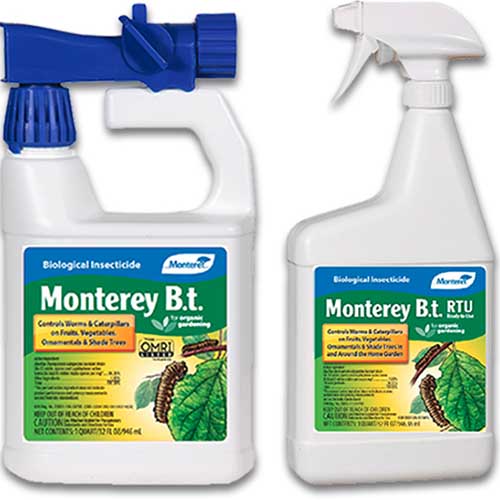
Monterey Bt Liquid
Arbico Organics carries it in 32-ounce ready-to-use and hose-end containers.
Insecticidal soap also works, so long as you keep reapplying it every seven days or so when the pests are present.
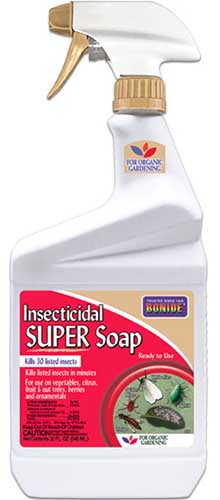
Bonide Insecticidal Soap
I use Bonide’s Insecticidal Soap, which is also available at Arbico Organics. They sell it in quart-sized ready-to-use bottles.
5. Cabbage Worms
You’d think from the name that cabbage worms would stick to feasting on cabbages, but any type of brassica is at risk of infestation by these larvae.
There are several types of cabbage worms to keep an eye out for: the large cabbage white or imported cabbage worm (Pieris rapae), the southern cabbage worm (Pontia protodice), the mustard white (Pieris napi), and the cross-striped cabbage worm (Evergestis rimosalis).
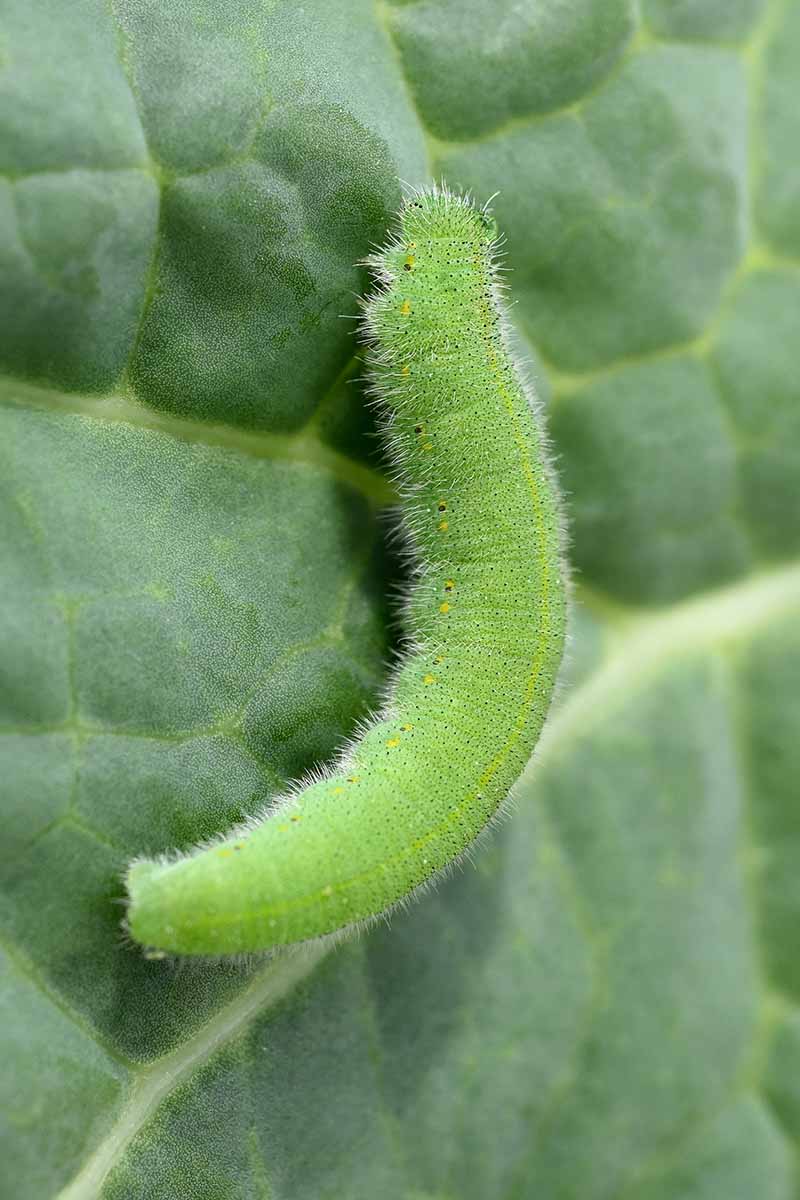
The cross-striped cabbage worm is bluish-gray with black horizontal stripes, and a single yellow stripe on each side.
Cabbage whites are green with a pale yellow stripe, while southern cabbage worms are green with multiple bright yellow stripes that extend over the length of their bodies.
Mustard whites have a dashed yellow line down their sides.
They will all chew holes in the leaves of your broccoli, which can stunt or even kill the plant if they appear in large enough numbers.

Handpicking any caterpillars you see is always a good idea. You should also do your best to encourage predators like birds, yellowjackets, and ladybugs to come to your garden.
If you don’t have lots of ladybugs in your garden naturally, you can purchase them at a local nursery or online.
Be sure to look for ones that have been raised in captivity rather than ladybugs collected from the wild and shipped elsewhere.
You can also use the same products on these pests that you would use to control cabbage webworms.
6. Cutworms
Cutworms are the larvae of certain species of moths from the Noctuidae family. These pests chew through the base of young broccoli plants, cutting them off and killing them.
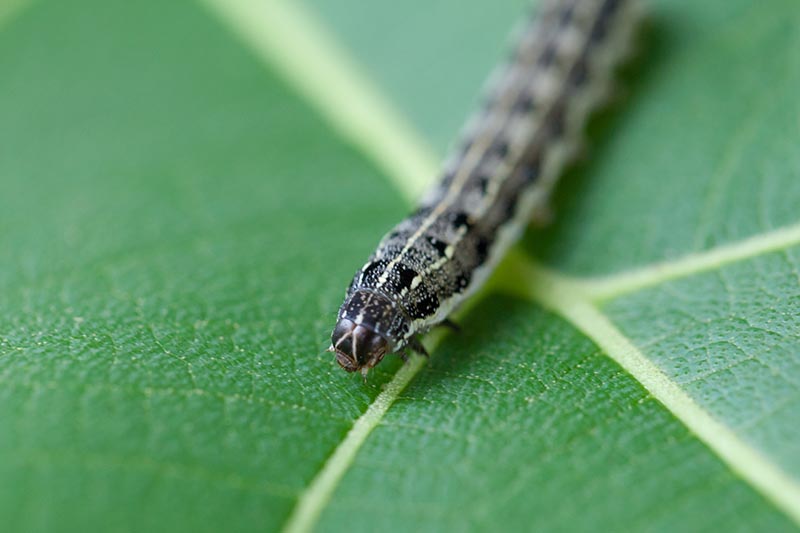
If you come outside one morning and find your seedlings dead on the ground and severed at the base, you can be pretty confident that you’ve got some of these wrigglers in your garden.
7. Diamondback Moth Caterpillars
In case you haven’t noticed yet, one of the most common varieties of pests you’ll face are caterpillars of all kinds. Diamondback moth caterpillars (Plutella xylostella) are yet another species that may plague your crop.
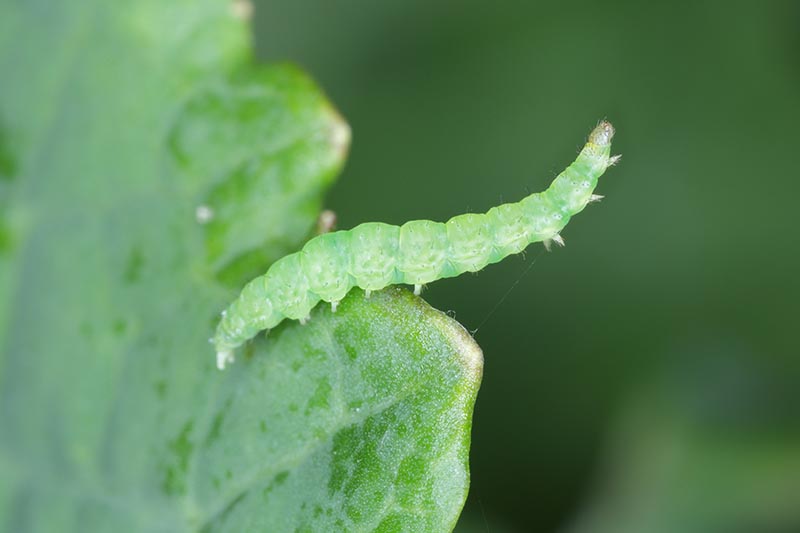
These creepy-crawlies are about a third of an inch long, and light green with small black hairs. They’re pointed on both ends, which helps to differentiate them from other types of caterpillars.
Another way to identify them is to disturb them; they’ll drop down on a silken thread to try to escape.
Treat them as you would cabbage worms or cabbage webworms.
8. Flea Beetles
Crucifer flea beetles (Phyllotreta cruciferae) are tiny beetles that hop around from plant to plant, nibbling little holes in the foliage.
They don’t typically cause as much damage to broccoli as they do to other crucifers, thanks to the waxy coating that covers the leaves. Usually, they’ll just feed on the margins of the foliage and don’t cause any serious damage.
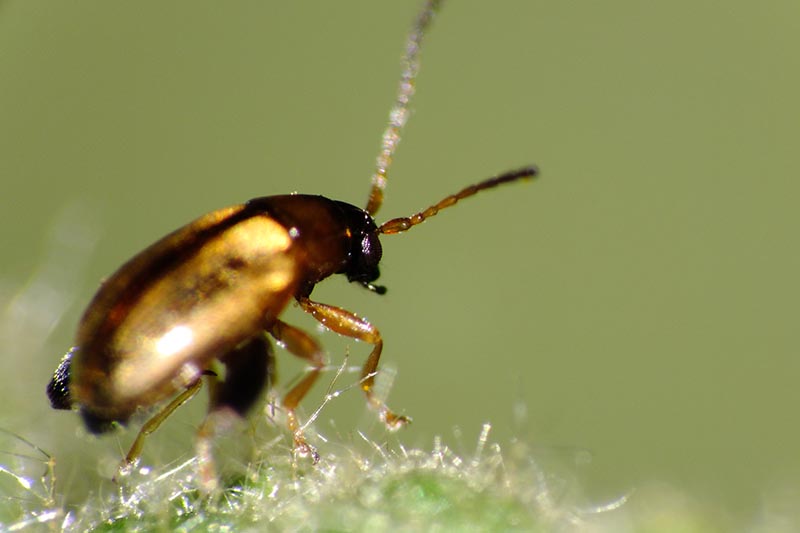
If the damage ended there, you could safely just ignore them. But they can also spread disease, so you should address an infestation before it causes more problems.
Even better, plan ahead to avoid having flea beetles visit your veggie patch in the first place.
Crop rotation, removing debris from the garden in the fall, and keeping weeds out throughout the season will go a long way towards discouraging these annoying pests.
Row covers are another excellent option. They prevent the beetles from landing on your crops in the first place.
It’s also a good idea to separate broccoli plants from each other with other non-cruciferous plants. This makes it more challenging for the beetles to find their favorite foods.
Anise, dill, chamomile, marigold, and clover are good options for companion planting, since they attract insects like damselbugs and lacewings, which are flea beetle predators.
9. Harlequin Bugs
Harlequin bugs (Murgantia histrionica) are a common pest in the southern half of the US, where they can cause serious financial losses by destroying commercial crucifer crops.
They can quickly ruin your home harvest too if you don’t keep them in check.
They feed on plants by piercing them and sucking out the sap. As they feed, the broccoli plants start to wilt and turn yellow or brown. Eventually, the plants may die.
The bugs have black and red or yellow spotted bodies with flat, shield-like shells. When mature, they are about a third of an inch long.
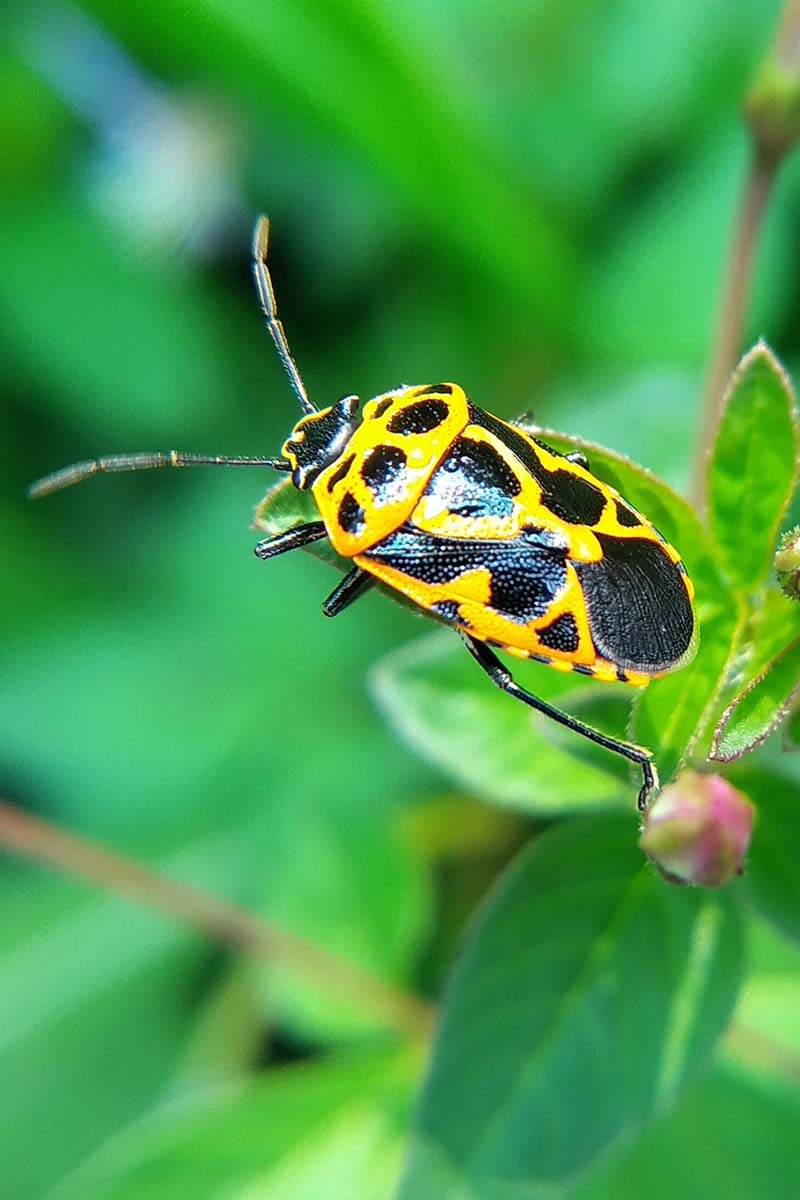
Your first line of attack should be to grab any harlequin bug that you see in your garden and drown it in soapy water.
As with the caterpillars on this list, encouraging predators like birds and ladybugs to visit can help, as can keeping your garden well-weeded.
Failing that, an insecticide that contains pyrethrins such as Monterey Bug Buster can be effective.
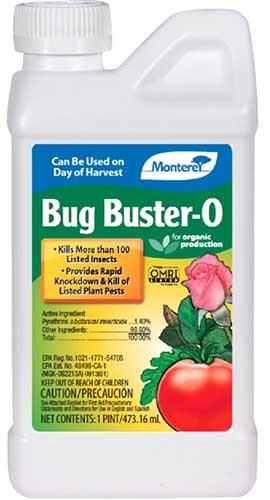
Monterey Bug Buster
Arbico Organics carries eight- and 12-ounce containers of this broad insecticide.
Spray your plants as soon as you note the presence of these beetles. Don’t use it for more than two years in a row, however, or you risk fostering resistance.
10. Root-Knot Nematodes
Root-knot nematodes (Meloidogyne spp.) are known to attack a massive range of plants, including broccoli and other cole crops.
These microscopic nematodes live in the soil and feed roots, causing knots and bumps to form in the roots and reducing the plant’s vigor.
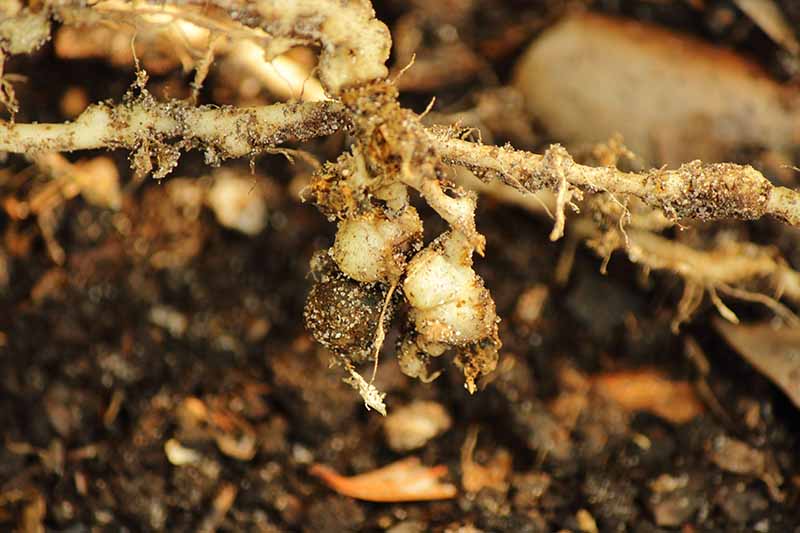
Above ground, it can be hard to tell if you’re dealing with this pest, since your plants will generally just look stunted or wilted.
You might also see some yellowing of the leaves. As you probably noted, all of these symptoms are pretty generic and common.
You can pull the plants to confirm the presence of nematodes. Look at the roots and examine them for galling.
Otherwise, you can send a soil sample to your local extension office for testing. Once your plant is infected, there is no cure.
Be absolutely sure to rotate your crops if you have an infestation of nematodes. Don’t plant anything in the same spot for at least four years.
You should also remove any weeds, since nematodes can survive on many different weed hosts.
You should also treat the soil with a nematicide.
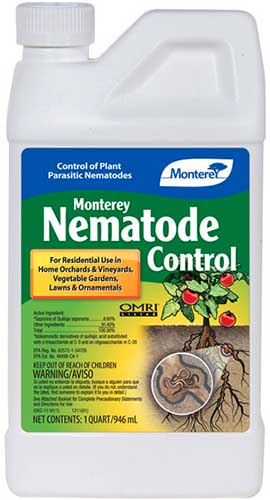
Monterey Nematode Control
There are many out there, so check with your local nursery for recommendations. Or, head over to Arbico Organics to grab a quart of Monterey Nematode Control, which may be applied as a soil soak.
You can learn more about root-knot nematodes in our guide.
11. Thrips
There are three kinds of thrips out there that are just waiting to get their sucking mouthparts into your broccoli plants: Western flower thrips (Frankliniella occidentalis), corn thrips (F. williamsi), and onion thrips (Thrips tabaci).
None of these prefer broccoli over their favorite foods, which are onions, garlic, corn, grains, nightshades, leafy greens, and cabbage. But they won’t turn down a broccoli meal if it’s on offer.
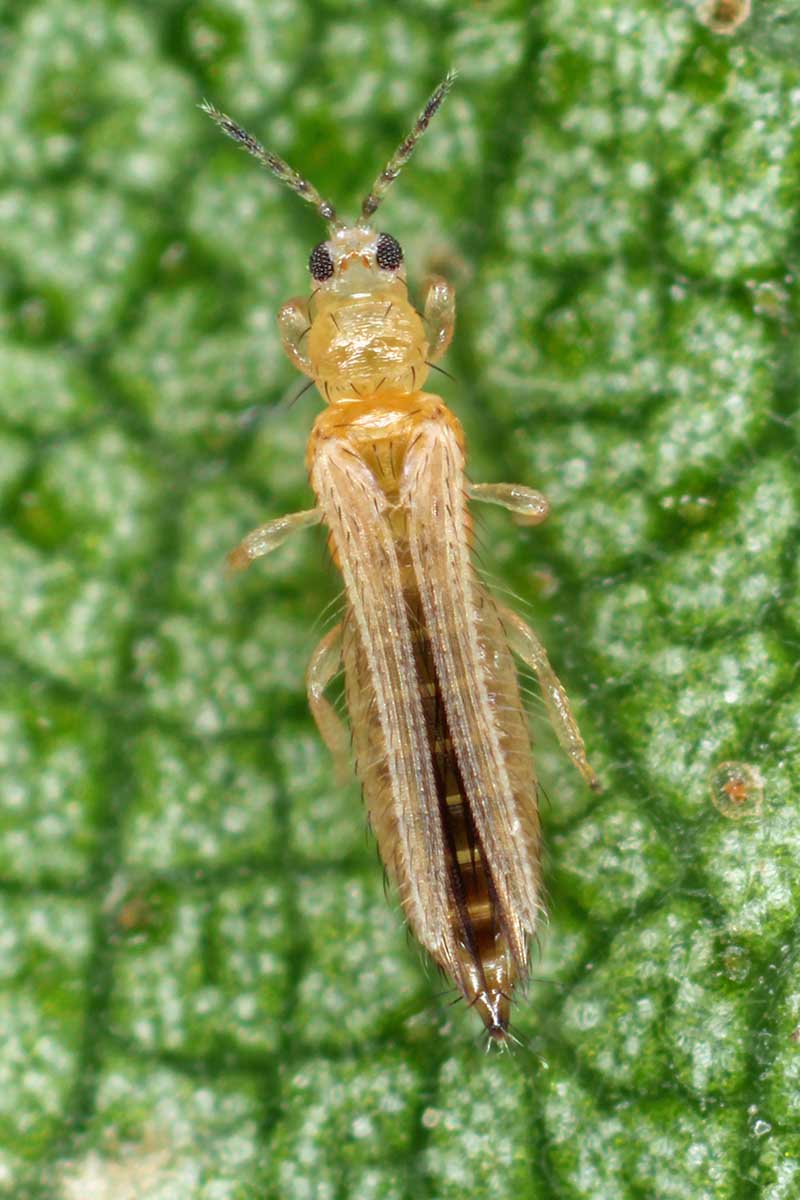
Thrips are small, usually about a third of an inch in length. Adults have wings, while the immature insects don’t. They can range in color from light yellow to dark brown. And they can produce up to eight generations per year.
While their feeding can cause some unwelcome symptoms, such as stippling and even stunting, the real danger is that they can spread disease, most notably mosaic virus.
On the bright side, they devour spider mites, so they’re not all bad. However, if you don’t have spider mites on your plants, they’ll start eating the plants instead.
Whether to treat a thrips infestation or not is a personal decision. Some gardeners opt to leave them alone, since they won’t usually do enough damage to prevent you from growing big, bountiful broccoli heads.
Plus, once they’ve infested your plants, they’ve probably already spread any diseases that they’re carrying, so it’s too late.
On the other hand, you can’t be too careful. If you decide to treat, insecticides containing spinosad, permethrin, or pyrethrins are effective, as is insecticidal soap.
Make your garden less appealing to these pests by introducing or encouraging minute pirate bugs, which are a natural predator. Keep weeds under control to deny thrips a place to hide.
Learn more about how to battle an infestation of thrips in our guide.
Beat Back Broccoli Pests
Looking at this list, you might think the battle against broccoli pests is futile. But a little bit of prevention goes a long way towards discouraging most of these pests.
Crop rotation, regular weeding, and encouraging beneficial insects and birds to come to your garden will make all the difference.
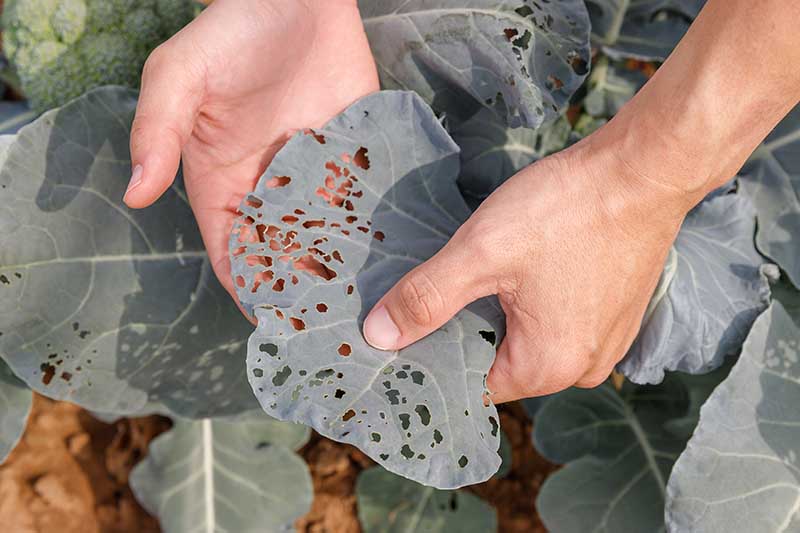
Insecticide For Broccoli Plants
1. Bt (Bacillus thuringiensis) Biological Insecticide: This product is a bacteria that kills leaf-feeding caterpillars and cabbage loopers, but does not harm bees or other beneficial insects. It is applied as a spray. The bacteria are inactivated when they come into contact with sunlight, so make sure to apply them between dusk and dawn. Bt is sold under the names Knockout and Thuricide.
2. Neem oil: Neem oil is derived from the neem tree and has been used for centuries in India as an insect repellent and pesticide. It is effective against aphids, caterpillars, beetles, thrips, mites, snails, earwigs and other pests. Because it can kill beneficial insects such as ladybugs, it should be applied only if there are no other biological controls available to manage the pest problem on your property. Neem oil is sold under the name Tree-age Oil by Monterey Garden Products
List Of Insecticide For Broccoli Plants
- INSECT KILLER – This pest control is great for use on cabbage looper, hornworms, tent caterpillar, gypsy moth, bagworm and many more.
- PROTECTS FRUITS, VEGETABLES, SHADE TREES & ORNAMENTALS – Designed for use on broccoli, cauliflower, kale, mustard greens, eggplant, pepper, melons, tomatoes, cabbage, shade trees and ornamentals.
- DOESN’T HARM BENEFICIAL INSECTS – Kills worms and caterpillar stage insects while causing no harm to birds, earthworms, or beneficial insects, such as honeybees and ladybugs.
- FAST ACTING FORMULA – Must be eaten by worms or caterpillars to be effective. After ingesting, bugs immediately stop feeding and will die within 2-3 days.
- ORGANIC GARDENING – The active ingredient of the product is a natural strain of the bacterium Bacillus thuringiensis, which is a leading insecticide used worldwide. Approved for organic gardening, our product is safe for use around people and pets.
Additional Info :
| Item Dimensions | |
| Height | 12 Inches |
| Width | 3 Inches |
| Length | 6 Inches |
| Weight | 2.33 Pounds |
| Release Date | 2021-11-10T00:00:01Z |
- Insect Killer – this pest control is designed for use on caterpillars and worm type insects, such as cabbage looper, bagworm, gypsy moth, fall cankerworm, elm spanworm and many more.
- Foliage protector – this insecticide is designed for use on a variety of plants including broccoli, Celery, cabbage, Turnip greens, mustard greens, Cauliflower, melons, lettuce, tomatoes, shade trees, ornamentals and many more.
- Safe for earthworms & bees – when used as directed, Monterey b.T. Has no effect on birds, earthworms, or beneficial insects such as honeybees or Ladybugs.
- Organic gardening – our insecticide is OMRI listed and approved for organic gardening. OMRI, the organic materials Review Institute, determines whether or not a product Qualifies as organic under the USDA’s national organic program.
- Easy to apply – product instantly mixes with water and should be applied using either a trigger spray bottle or pressure tank sprayer. Carefully read and use according to label directions.
- Power Source Type: Air Powered
Additional Info :
| Color | 16 Oz. |
| Item Dimensions | |
| Height | 7 Inches |
| Width | 4 Inches |
| Length | 2 Inches |
| Weight | 1.2000003429148 Pounds |
- CONTAINS BOTANICAL INSECTICIDES: Spray on roses, vegetables, houseplants, ornamentals, trees, shrubs and flowers right up to the day of harvest.
- KILLS ON CONTACT: Kills aphids, tomato hornworms, green fruitworms and other listed insects.
- PROTECTS YOUR WHOLE GARDEN: Use both indoors and outdoors.
- READY-TO-USE PEST CONTROL: Spray upper and lower leaf surfaces – no mixing required.
- APPLY AS NEEDED: Treat weekly or apply as needed to control infestations (up 10 to times per season).
Additional Info :
| Item Dimensions | |
| Height | 10.33 Inches |
| Width | 2.25 Inches |
| Length | 4.25 Inches |
| Weight | 3 Pounds |
- Size: 16 OZ
- Thuricide BT Caterpillar Control concentrate is used by organic gardeners and is made from bacteria that is toxic to listed pests.
- Safe to use on all plants, vegetables and edible crops.
- Very low toxicity to humans and pets.
- For large quantity discount consideration or to request a mixed multi-pack, please message us.
Additional Info :
| Item Dimensions | |
| Height | 6 Inches |
| Width | 1.75 Inches |
| Length | 4 Inches |
| Weight | 0.62 Pounds |
- Insect Killer – this pest control is great for use on caterpillars, leafminers, loopers, trips, moths, fruit flies, borers, flea beetles and many more.
- Foliage protector – this liquid concentrate is designed for residential use in lawns, home gardens & ornamentals. Some example uses include apples, Asparagus, Basil, Lemongrass, broccoli, grapes, Eggplant, Celery, strawberries, Peas and more.
- Contains spinosad – the active ingredient of garden insect spray is spinosad. Spinosad is a natural substance made by a soil bacterium that is toxic to insects. It is used to control a wide variety of pests.
- Organic gardening – our insecticide is OMRI listed and approved for organic gardening. Omri, the organic materials Review Institute, determines whether or not a product Qualifies as organic under the usda’s national organic program.
- Ready to use – garden insect spray is conveniently ready to use when it arrives. Apply directly from the container which is fitted with a trigger sprayer.
Additional Info :
| Item Dimensions | |
| Height | 8.5 Inches |
| Width | 2.5 Inches |
| Length | 4.5 Inches |
| Weight | 2 Pounds |
